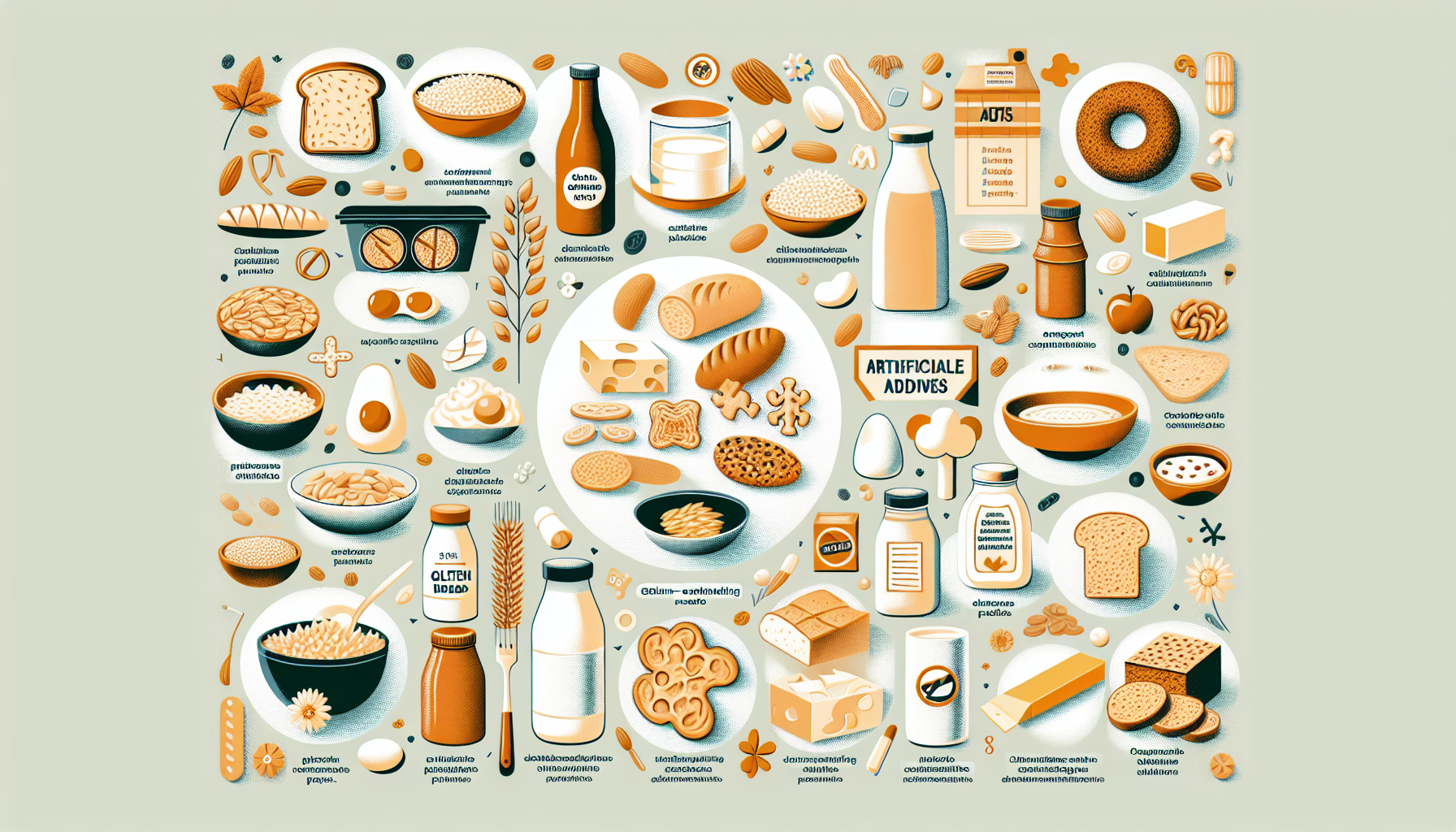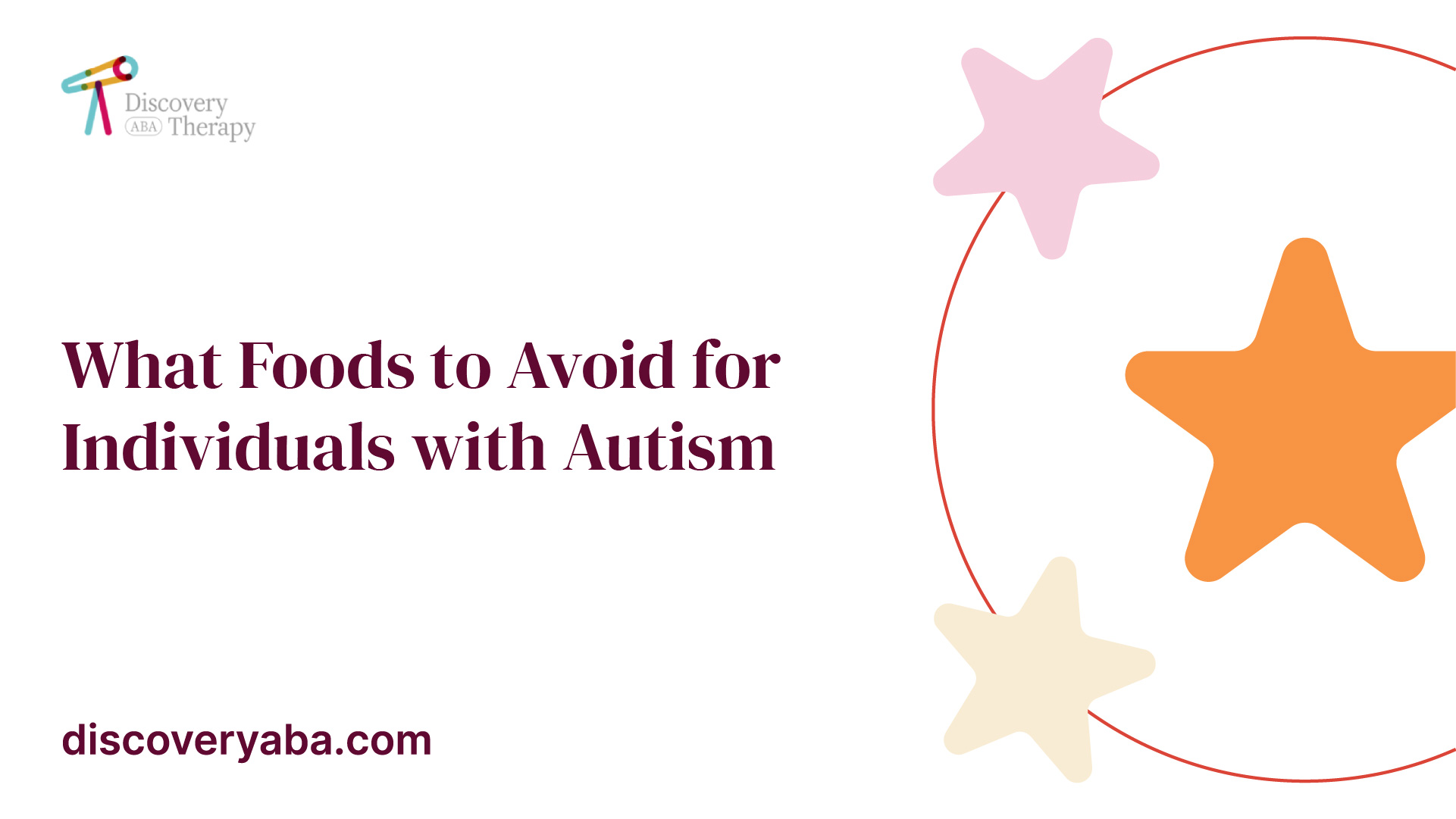What Foods to Avoid for Individuals with Autism
Unlock the secrets: What foods to avoid with autism? Discover the impact of sugar, additives, and textures for individuals with autism.

Foods to Avoid with Autism
When it comes to individuals with autism, certain foods may have a negative impact on their well-being. It is important to be aware of these foods and their potential effects. Here are some key categories of foods to avoid for individuals with autism:
Harmful Food Additives
Certain food additives, especially propionic acid (PPA) found in many processed foods, can be harmful to individuals with autism. PPA has been linked to alterations in mitochondrial function, decreased antioxidant enzymes, and increased oxidative stress, potentially impacting gut health. It is advisable to read food labels and avoid foods that contain harmful additives.

Artificial Colors and Hyperactivity
Artificial colors, particularly those containing tartrazine and other azo dyes, have been associated with hyperactivity in autistic children. These dyes have also been linked to conditions such as ADHD, asthma, and allergies, making it important to avoid foods that contain them.
Artificial Sweeteners and Gut Health
Artificial sweeteners, such as aspartame and saccharin, should be avoided by individuals with autism. These sweeteners have been found to contribute to gut dysbiosis, which refers to an imbalance in the gut bacteria. Maintaining a healthy gut is crucial for overall well-being, and avoiding artificial sweeteners can help promote gut health.
Gluten and Casein Sensitivities
Gluten and casein, proteins found in wheat and dairy products, can be challenging for some individuals with autism to digest. They may cause issues with the gut, leading to discomfort and other symptoms. Eliminating gluten and casein from the diet may be beneficial for some individuals with autism, as it can help improve their symptoms.
It is important to note that the effects of these foods can vary among individuals with autism. It may be helpful to work closely with healthcare professionals and consider personalized nutrition plans to identify specific sensitivities and develop suitable dietary strategies. By avoiding harmful food additives, artificial colors, artificial sweeteners, gluten, and casein, individuals with autism may potentially experience improvements in their overall well-being.
The Impact of Food Textures
The texture of food plays a significant role in the dietary experiences of individuals with autism. Food texture hypersensitivity is common among children with autism, making it important to understand the impact it can have on their eating habits and preferences. In this section, we will explore the challenges with mixed texture foods, heightened sensitivity to textures, and the potential benefits of introducing aversive textures.
Challenges with Mixed Texture Foods
Foods with a mixed texture, such as soups, stews, and casseroles, can pose challenges for individuals on the autism spectrum. The combination of different textures in these dishes can be overwhelming for individuals with food texture hypersensitivity. The varying textures can create sensory overload and lead to aversions or difficulties in consuming these types of foods.
Heightened Sensitivity to Textures
Individuals with autism may experience heightened sensitivity to certain textures. Sticky, creamy, or crunchy textures, for example, can be particularly challenging for those with food texture hypersensitivity. These textures may trigger sensory discomfort or even evoke a strong aversion response, making it difficult for individuals to enjoy or tolerate foods with these textures.
Introducing Aversive Textures
Despite the challenges associated with food texture hypersensitivity, there are strategies that can help individuals with autism broaden their food acceptance. One approach is to introduce aversive textures in a structured manner. By gradually exposing individuals to textures they find aversive, under the guidance of a healthcare professional or therapist, it is possible to desensitize their sensory responses and reduce food neophobia, which is the fear of new or unfamiliar foods.
This structured approach allows individuals to gradually become more comfortable with textures that were previously challenging for them. It is essential to respect an individual's preferences and pace during this process to ensure a positive experience and promote acceptance of a wider variety of foods.
In addition to introducing aversive textures, children with autism may benefit from food therapy and sensory-based feeding programs. These programs are designed to address their specific food texture sensitivities and help improve their nutritional intake. By working with healthcare professionals and therapists, individuals can receive personalized strategies and support to navigate their food texture hypersensitivity and expand their dietary options.
Factors such as age, level of sensory sensitivities, and co-existing conditions can influence an individual's food texture preferences and aversions. Therefore, it is crucial to adopt individualized approaches when addressing food texture hypersensitivity in individuals with autism. By tailoring interventions to their specific needs, it becomes possible to help individuals with autism navigate the challenges associated with textures and create a more enjoyable and nutritious eating experience.
Strategies for Managing Food Texture Hypersensitivity
Individuals with autism often experience food texture hypersensitivity, which can make mealtime challenging. However, there are strategies and approaches that can help manage this sensitivity and promote a more enjoyable eating experience.
Food Therapy and Sensory-based Feeding Programs
Food therapy and sensory-based feeding programs are valuable resources for children with autism who struggle with food texture hypersensitivity. These programs are designed to address specific food texture sensitivities and improve nutritional intake. Through specialized therapy sessions, children can gradually explore and become familiar with different textures, allowing them to expand their food acceptance.
These programs often involve sensory play, exposure to various textures, and systematic desensitization techniques. The goal is to help individuals with autism develop a more positive relationship with food textures and increase their willingness to try new foods.
Individualized Approaches
Each individual with autism is unique, and their food texture preferences and aversions can vary greatly. Therefore, it is crucial to take an individualized approach when managing food texture hypersensitivity. Factors such as age, level of sensory sensitivities, and co-existing conditions can influence these preferences.
Parents, caregivers, and healthcare professionals should work together to understand the specific food texture challenges faced by the individual. By tailoring strategies and interventions to their specific needs, it becomes possible to create a more supportive and accommodating mealtime environment.
Factors Influencing Food Texture Preferences
Understanding the factors that influence an individual's food texture preferences is essential for managing food texture hypersensitivity in autism. Besides age and sensory sensitivities, other factors such as past experiences, cultural influences, and cognitive abilities can impact an individual's willingness to try or avoid certain textures.
By considering these factors, parents, caregivers, and therapists can develop a better understanding of the individual's unique needs and tailor interventions accordingly. Creating a safe and supportive atmosphere that respects an individual's preferences can help foster a positive relationship with food and encourage exploration of different textures over time.
By implementing food therapy, individualized approaches, and considering the factors that influence food texture preferences, individuals with autism can gradually overcome texture hypersensitivities and expand their food choices. With patience, support, and a multidisciplinary approach, mealtime can become a more enjoyable and nourishing experience for individuals with autism.
Sugar and Autism
When it comes to individuals with autism, there is a growing interest in understanding the impact of diet on their symptoms. Sugar consumption is one area of focus, as some parents report that their children with autism are sensitive to artificial food colorings, flavors, preservatives, and may avoid sugars in general. In this section, we will explore the relationship between sugar and autism, including sensitivity to sugar, hyperactivity and energy levels, and individual variations in sugar sensitivity.
Sensitivity to Sugar
High sugar consumption has been linked to increased hyperactivity in some children with autism. While more research is needed to understand the exact mechanisms behind this connection, some individuals with autism may experience fluctuations in behavior and energy levels when consuming sugary foods. It is important for caregivers and parents to be mindful of the potential impact of sugar on their child's overall well-being.
Hyperactivity and Energy Levels
Although the impact of sugary foods on autism symptoms can vary between individuals, it is important to note that some children with autism may exhibit increased hyperactivity after consuming sugary foods. This can lead to challenges in managing their behavior and may affect their overall energy levels. Caregivers and parents should monitor and observe their child's response to sugar intake to determine if there is a noticeable impact on their behavior and energy levels.
Individual Variations in Sugar Sensitivity
It is vital to recognize that individuals with autism can have varying degrees of sensitivity to sugar. While some children may experience noticeable changes in behavior and energy levels after consuming sugary foods, others may not exhibit the same reactions. The impact of sugar on autism symptoms is highly individualized, and what works for one person may not apply to another.
To better understand the relationship between sugar and autism in an individual, it is crucial to observe and document their responses to different foods. This can help identify any patterns or correlations between sugar intake and changes in behavior or energy levels. Working closely with healthcare professionals, such as registered dietitians or doctors specializing in autism, can provide valuable insights and guidance when developing personalized nutrition plans.
While it may be beneficial for some individuals with autism to limit their sugar intake, it is important to note that a well-balanced diet tailored to their specific needs is key. Caregivers should focus on providing nutritious, whole foods and consider working with healthcare professionals to develop suitable dietary plans that address individual sensitivities and nutritional requirements.
Dietary Interventions for Autism
For individuals with autism, dietary interventions can play a role in managing symptoms and improving overall well-being. Among the various approaches, three commonly recommended diets are the gluten-free diet, the casein-free diet, and the gluten-free and casein-free (GFCF) diet.
The Gluten-Free Diet
Gluten, a protein found in wheat, barley, and rye, has garnered attention in its potential connection to Autism Spectrum Disorder (ASD). While there is an expanding body of literature examining the relationship between ASD and the gluten-free diet (GFD), the value of individuals with ASD going gluten-free remains uncertain.
However, some individuals with autism may benefit from a gluten-free diet, as it has been reported to ameliorate behavioral and intellectual problems associated with ASD. The diet involves avoiding foods that contain gluten, such as bread, pasta, cereals, and baked goods made from wheat, barley, or rye. Instead, individuals can opt for gluten-free alternatives made from rice, corn, quinoa, or other gluten-free grains.
The Casein-Free Diet
Casein is a protein found in milk and dairy products. Similar to gluten, casein is often considered a potential exacerbating factor in ASD. Some individuals with autism may experience behavioral improvements when following a casein-free diet [5].
The casein-free diet involves eliminating dairy products such as milk, cheese, yogurt, and butter from the diet. Alternative non-dairy options like almond milk, coconut milk, and soy milk can be used as substitutes. It's important to note that calcium and other nutrients typically obtained from dairy should be sourced from other foods or through supplementation, under the guidance of a healthcare professional.
The Gluten-Free and Casein-Free (GFCF) Diet
The gluten-free and casein-free (GFCF) diet combines the principles of both the gluten-free and casein-free diets. It aims to eliminate both gluten and casein from the individual's diet, as some research suggests that this combined approach may have a positive impact on symptoms of autism.
Implementing a GFCF diet should be done under the supervision of a healthcare provider or a dietitian to ensure that the individual is still receiving adequate nutrition and that the diet is appropriate for their specific needs. It's important to work with a healthcare professional to ensure that the dietary changes are implemented safely and effectively.
While the gluten-free diet, the casein-free diet, and the gluten-free and casein-free diet may be beneficial for some individuals with autism, it's important to remember that each person's response to dietary interventions may vary. Consulting with healthcare professionals and considering individual sensitivities and needs is crucial when implementing these dietary changes.
Personalized Nutrition Plans
When it comes to individuals with autism, it is crucial to develop personalized nutrition plans that cater to their specific needs and sensitivities. Working with healthcare professionals, such as registered dietitians or nutritionists, can be instrumental in creating suitable dietary plans. These professionals possess the expertise to guide caregivers and individuals with autism in making informed choices regarding their nutrition.
Working with Healthcare Professionals
Collaborating with healthcare professionals is essential in developing personalized nutrition plans for individuals with autism. Registered dietitians or nutritionists can assess the individual's dietary requirements, consider their specific sensory challenges, and identify any existing food sensitivities or allergies. By working together, caregivers and healthcare professionals can create a comprehensive plan that meets the nutritional needs of the individual while addressing any potential dietary concerns.
Identifying Individual Sensitivities
Identifying individual sensitivities is a crucial step in creating personalized nutrition plans for individuals with autism. Healthcare professionals can help identify specific foods that may trigger adverse reactions or exacerbate certain symptoms of autism [7]. This process may involve detailed assessments, consultations, and even food elimination trials to determine which foods might be best avoided. By pinpointing these sensitivities, healthcare professionals can tailor the nutrition plan to support the individual's overall health and well-being.
Developing Suitable Dietary Plans
Once individual sensitivities and dietary requirements have been identified, healthcare professionals can develop suitable dietary plans that meet the specific needs of individuals with autism. These plans may include recommendations for avoiding certain foods or food additives that could potentially worsen symptoms or trigger adverse reactions. Additionally, they may focus on incorporating nutrient-rich foods and ensuring a balanced diet that supports optimal health.
It is important to note that implementing dietary changes for individuals with autism should always be done under the supervision of healthcare professionals. This ensures that the individual continues to receive adequate nutrition and that the dietary plan is appropriate for their specific needs. Healthcare professionals can monitor the individual's progress, make adjustments as necessary, and provide ongoing support and guidance throughout the process.
By working in collaboration with healthcare professionals, caregivers and individuals with autism can develop personalized nutrition plans that optimize health and well-being. These plans take into account individual sensitivities, dietary requirements, and overall nutritional needs, providing a framework for making informed dietary choices that support the unique needs of individuals with autism.
Foods to Consider Avoiding with Autism
For individuals with autism, there are certain foods that may be best to avoid due to specific sensitivities and potential impacts on symptoms. It's important to note that each person with autism is unique, and what works for one individual may not apply to another. However, considering these factors and being cautious with food choices can be beneficial.
Specific Food Sensitivities
Certain food additives and preservatives have been found to be particularly harmful to individuals with autism. For example, propionic acid (PPA), commonly found in many processed foods, can alter mitochondrial function, decrease antioxidant enzymes, and increase oxidative stress, potentially causing a negative impact on the gut. Artificial colors, especially those containing tartrazine and other azo dyes, have been linked to hyperactivity in autistic children, as well as ADHD, asthma, and allergies. Artificial sweeteners like aspartame and saccharin should also be avoided as they can lead to gut dysbiosis, altering the composition of gut bacteria.
Link Between Certain Foods and Autism Symptoms
Gluten and casein, proteins found in wheat and dairy products, have been identified as potential triggers for individuals with autism. Some individuals may have difficulty digesting gluten and casein, leading to gut-related issues. Eliminating these proteins from the diet has shown improvement in symptoms for some individuals with autism. Although the research is not conclusive, some studies suggest a possible link between specific foods and symptoms of autism, emphasizing the importance of considering dietary choices for individuals with autism.
Cautious Food Choices for Autism
In general, it is advisable for individuals with autism to be cautious with certain food choices. Many parents report that their children with autism are sensitive to artificial food colorings, flavors, and preservatives, and may also avoid sugars in general. High sugar consumption has been linked to increased hyperactivity in some children with autism, and some individuals may experience fluctuations in behavior and energy levels when consuming sugary foods. Additionally, certain food additives like monosodium glutamate (MSG) and high fructose corn syrup should be avoided, as they can potentially affect behavior and cognitive function in children with autism.
When considering food choices for individuals with autism, it is crucial to consult with healthcare professionals and consider individual sensitivities. Personalized nutrition plans, developed with the guidance of healthcare providers, can help identify specific dietary needs and avoid potentially problematic foods. By being aware of specific food sensitivities, the link between certain foods and autism symptoms, and making cautious food choices, individuals with autism can potentially manage their condition more effectively.
Implementing Dietary Changes for Autism
When considering dietary changes for individuals with autism, one commonly recommended approach is the Gluten-Free and Casein-Free (GFCF) diet. However, it is important to implement such changes under the supervision of healthcare providers to ensure appropriate nutrition and suitability for individual needs.
Gluten-Free and Casein-Free (GFCF) Diet Considerations
The GFCF diet involves the elimination of gluten, a protein found in wheat, barley, and rye, as well as casein, a protein found in dairy products. Some individuals with autism may experience improvements in behavioral symptoms and cognitive function when following this diet. However, it is important to note that the value of implementing a gluten-free diet for individuals with autism is still uncertain and subject to ongoing research.
The GFCF diet aims to reduce inflammation, improve gut function, and potentially alleviate certain symptoms of autism. It is crucial to understand that this diet may not work for everyone, and individual responses may vary. Consulting with healthcare professionals or dietitians who specialize in autism is essential before making any dietary changes.
Supervision of Healthcare Providers
Implementing a GFCF diet should always be done under the supervision of healthcare providers or dietitians. They can ensure that the individual continues to receive adequate nutrition and monitor any potential nutritional deficiencies that may arise from eliminating certain food groups. Healthcare professionals can also provide guidance and support throughout the dietary transition, helping to address any concerns or challenges that may arise.
Impact of Removing Gluten and Casein
Research suggests that a GFCF diet might help improve some symptoms of autism in certain individuals by reducing inflammation and improving gut function [5]. However, it is important to remember that the impact of removing gluten and casein can vary among individuals. Some individuals may experience noticeable improvements in behavior, while others may not see significant changes. It is crucial to approach dietary changes with realistic expectations and to monitor the individual's progress closely.
By implementing the GFCF diet under the guidance of healthcare professionals, individuals with autism can explore the potential benefits of this dietary approach. However, it is essential to consider the individual's specific needs, preferences, and responses to the diet. The expertise and support of healthcare providers or dietitians can help ensure that the dietary changes are implemented safely and effectively.
References
- https://worldstemcellsclinic.com/blog/eating-for-autism-food-additives-that-destroy-the-gut/
- https://www.autismparentingmagazine.com/food-texture-hypersensitivity/
- https://www.autismspeaks.org/sugar-and-autism
- https://www.ncbi.nlm.nih.gov/pmc/articles/PMC7915454/
- https://www.autism.org.uk/advice-and-guidance/professional-practice/gluten-casein-free
- https://www.frontiersin.org/articles/10.3389/fnut.2022.927212
- https://leafwingcenter.org/avoid-foods-autism/
Find More Articles
Contact us
North Carolina, Tennessee, Nevada, New Jersey, Utah, Virginia
New Hampshire, Maine
Massachusetts, Indiana, Arizona, Georgia
.avif)






























































































